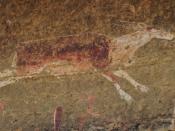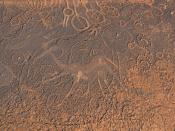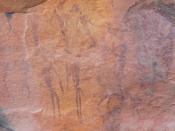Rock art - a term in archeology for any man-made markings made on natural stone. (Wikipedia, 13/04/07, 16:45)Rock art can be divided into two sections - Petroglyphs (Where marks are carved into stone surfaces) and Pictographs (where marks are made with paint on rocks or caves). Both pertroglyphs and pictographs can be either parietal (on the walls of a cave or rock shelter) or in open air, exposed to the elements on outcrops ect.Petroglyphs are made through the removal of rock, scratching, pecking, carving ect to remove rock, exposing the usually lighter rock interior against the darker patina (a dark mineral accumulation on rock surfaces). This was usually done with a sharp, pointed rock harder than the rock being engraved.
Pictographs are made using pigments to colour the rock. These images were mostly drawn rather than painted as we paint today. One of the reasons the rock art we study today is still visible is because of the use of mineral pigments, eg.
manganese, hematite, malachite, gypsum, limonite, clays and various oxides. The amazingly fine lines are evidence of the development of very fine brushes (made from sticks, hairs or feathers), but pallets and hands were also used. Most paintings are one colour - most commonly red although some paintings have up to four colours - and usually outlines were drawn fist and then filled in. The image would usually be "flat", although there have been examples of shading. The paint was made from a range of substances, consisting of pigment and then a binding.
The SanSan, or the slightly derogatory term "busmen" or more offensive "hottentot" rock art is one of the most well known sectors of rock art in the world. Although it is so well known, there is a lot of confusion and misconceptions about...


